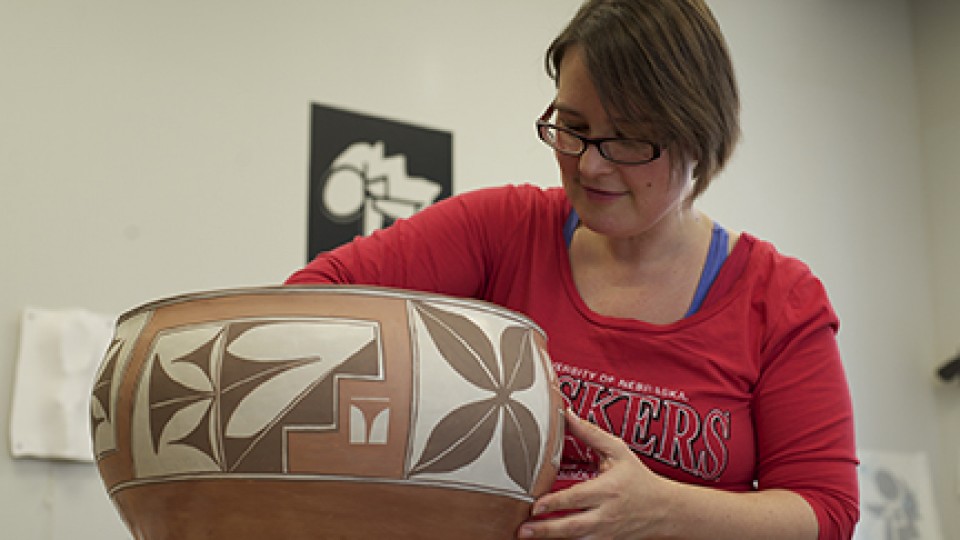· 4 min read
‘Making History’ exhibition opens Dec. 1

Margaret Bohls, UNL assistant professor of art, teaches a special topics class called “Making History,” which gives ceramics students the chance to study the history of ceramics by recreating historical objects. The students’ work will be displayed in an exhibition at the Eisentrager•Howard Gallery Dec. 1-5. A closing reception will be held from 5-7 p.m. Dec. 5 in the gallery.
The model for this new course came from a class Bohls team-taught at Nova Scotia College of Art and Design with ceramic artist Julia Galloway. The course combines lectures on the history of ceramics with studio time and allows students to recreate four objects of their choosing. They must reproduce the objects as faithfully as possible in scale, technique, materials and firing process within the capabilities of the UNL Ceramics Studio.
“Art students seem to learn better if they’re making things at the same time as they’re looking at images and reading,” Bohls said. “The other thing that’s really great is that rather than just studying about the history of the objects and the aesthetic qualities about the objects, they’re also learning process and material. They’re training their eyes to see the real particular qualities of these historic objects. I think it makes it a richer experience for them to be able to study these objects through making.”
The class has 19 students in it, including seven graduate students and 12 undergraduates.
Bohls said the class helps fill a gap in the regular art history curriculum.
“Students don’t see a lot of craft objects, and they certainly don’t see a lot of ceramics,” she said. “So I’m trying to flesh out their education in that way. Ceramics is a medium that relies heavily on history and tradition and process and material. I think that it’s important for ceramics students to get that kind of information.”
Rikki Neumann, a junior art major, took the class because of Bohls.
“If you’ve ever met anybody who is really into ceramics, we kind of nerd out and geek out on it,” Neumann said. “That’s how Margaret is with this history class, because it’s just something that she’s really passionate about. I knew that about her, so I knew it would be a really awesome class.”
Neumann is making a smiling figure from Veracruz, Mexico; an Egyptian Paste figure of Isis and her son Horus; and a Sancai vase from the Tang Dynasty.
Neumann said Bohls wants students to get in touch with the person who made the object originally.
“That’s what I was trying to do. The figure one, I got done making it, and it was almost like I was in a trance when it was done because there’s so much detail,” she said. “You take a step back, and you really were in that person’s shoes making it, trying to figure out how they did it.”
First-year graduate student Louise Deroualle, who is from Sao Paulo, Brazil, is making objects from ancient Native American cultures, focusing on the Anasazi culture for one of the projects and on the Mimbres culture for another one.
“I’ve always been interested in pre-Columbian pottery and until coming to UNL, I was more familiar with South America’s ancient cultures,” she said. “I am currently living in the U.S. studying in an American university and with American teachers and fellow American grad students, so it just made sense to study the ‘local’ culture. By studying the Southwest ancient cultures, I’m studying the roots of ceramics in the U.S.”
She said she is learning both technical craft skills as well as historical facts in the class.
“The Mimbres culture I’m researching have exceptional decorations on their pots, and their way of organizing the space and dealing with negative and positive images is exquisite,” Deroualle said. “I already know that being aware of that has changed my perception of how I’m conceiving some of my pieces.”
An important part of the class is also the exhibition, said Bohls.
“What happens when students install the work in the show is they have to conceptualize the relationship between those objects,” she said. “When we talk about them and give slide lectures, we have to divide them up in some way, so we divide them by culture and time period. But there’s all this information that goes across borders. It is also great for them to begin to see the relationships and even cultures that never necessarily had any contact with one another. Developmentally they go through the same stages in making things, so you can see real, strong relationships. It’s a physical activity where they’re moving things around in the gallery and thinking about what should go with what.”
The Eisentrager•Howard Gallery is located on the first floor of Richards Hall. Gallery hours are 12:30 to 4:30 p.m. weekdays. Admission to the gallery is free and open to the public.
For more information, click here.







